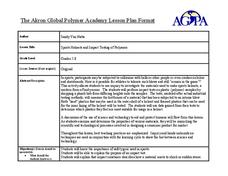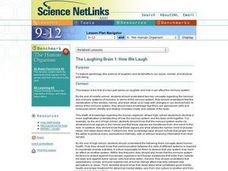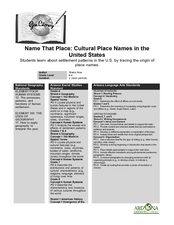Curated OER
The Ultimate Predator
Students listen to a lecture by the teacher about the "Ultimate Predator." They design a new "Ultimate Predator." Students present their creations to the class and attempt to convince their classmates that their predator is indeed the...
Curated OER
Extensions - Biology Review Unit
Students engage in a variety of activities in order to review a Biology unit. For example, they research the Bird Flu, it's history, how it is spread, what has been done about it, what better options exist for controlling or removing it....
Curated OER
Sports Helmets and Impact Testing of Polymers
Students examine the importance of good quality safety gear. In this investigative lesson, students will tests various polymers, collect data, and analyze the data to determine which polymer is best for safety helmets. They will design a...
Biology Junction
Flatworms
In this flatworms instructional activity, learners identify and color the different parts of a flatworm. They complete 14 short answer questions related to the topic.
Curated OER
"Garden Springs Gardeners"
First graders ponder the question of how plants help their lives. They observe and compare properties of several different plants. Differentiate between living organisms and nonliving objects.
Curated OER
Live Well Now to Live Longer Later
Ninth graders select a topic to research, completing the sentence, "Are the effects of _______ really that detrimental to one's health?" They record information in a journal, including sources of information. Students work in groups with...
Curated OER
Discovering the Structure of the Atom
Students investigate atomic and nuclear structure of matter by researching historical atomic theories. Students examine Rutherford's studies and discover that many scientific conclusions change over time as new data is collected.
Curated OER
Hazard Mitigation: Bioterrorism
Students discuss different ways to spread infectious diseases. In this bioterrorism lesson, students model the rate of smoke emission using CalRoad software. They analyze the effects of airborne release of biological...
Curated OER
Virus Tracker
Sixth graders will simulate the spread of a virus such as HIV through a population by "sharing" (but not drinking) the water in a plastic cup with several classmates. Although invisible, the water in a few of the cups will already be...
Curated OER
Pulse Rates
Students answer the question, "How will the intensity of exercise effect your heart rate?", using physical workouts and AppleWorks, or similar spreadsheet program. This instructional activity can conclude with the creation of a graph of...
Curated OER
Vital Vitamins
Students study vitamins and who should take them and what ones to take. In this investigative lesson students plan a healthy diet after reviewing the types of supplements.
Curated OER
The Laughing Brain 1: How We Laugh
Students to rate themselves on a scale from 1 to 10 (10 being the happiest) as to how happy they feel and write their rating on a sheet of paper. They explore gelotology (the science of laughter) and its benefits to our social, mental,...
Curated OER
Can You Beat Jet Lag?
Learners examine the health condition of jet lag. Using mealworms, they test the effect of light on the development of them into adults. They answer discussion questions and examine the relationship of age and one's activity level.
Curated OER
The United Nations
Students are introduced to the role of the United Nations. Using the internet, they research its history and its influence on politics and peace. In groups, they create a timeline of significant United Nations conventions since World...
Curated OER
Diseases of the Eye
Fifth graders research diseases of the eye. In this science lesson, 5th graders discuss and research eye diseases and complete a worksheet using the information they find.
Curated OER
Mathematics In You
Students construct ratios using the hand as data. They use examples of cortical and trabecular bone found in the long bones to measure circumference, diameter, length, and weight of long bones. They perform computations using growth...
Curated OER
Name That Place: Cultural Place Names in the United States
Young scholars examine the origin of the people that settled in the United States. In this United States History instructional activity, students work in small groups to complete several activities that explore early settlement,...
Curated OER
Peeled Trees Tell The Story
Students investigate the diversity of life that is found in Montana. They research some of the different interactions that organisms have with their environment. The lesson plan includes an extensive introduction for teacher information....
Curated OER
The Food Pyramid
Third graders investigate the concept of The Food Pyramid and its importance as a foundation for good health. They use the computer lab as a class to construct projects using the Kidpix software to make their own imitations of The Food...
Curated OER
Land Use and Nitrogen
Students consider the effects of development on water quality. They test nitrogen levels in waters before and after development, investigate wastewater treatment options and research best management practices to reduce nitrogen loads.
Curated OER
Adaptations
Eighth graders choose an animal and research its various adaptations using
their information, 8th graders create an informational tri-fold brochure or newsletter. They should include facts about the animal's adaptations as well as...
Curated OER
Hickory Dickory Dock: The Biological Clock
Young scholars investigate the effect of day length on animal migrations. They view a Powerpoint presentation, identify their own personal migrations and cues, answer discussion questions, and test a hypothesis about seasons.
Curated OER
Insects and Spiders
Students make either and insect or a spider using materials their teacher provides. They then draw of picture of their organism and defend why it is either a spider or an insect.
National Cancer Institute at the National Institutes of Health
Seer Training Modules: Introduction to the Human Body
Self-guided learning activity where students learn about the functions, processes, and anatomy of the human body. There is a short quiz at the end of the lesson to check for understanding.























